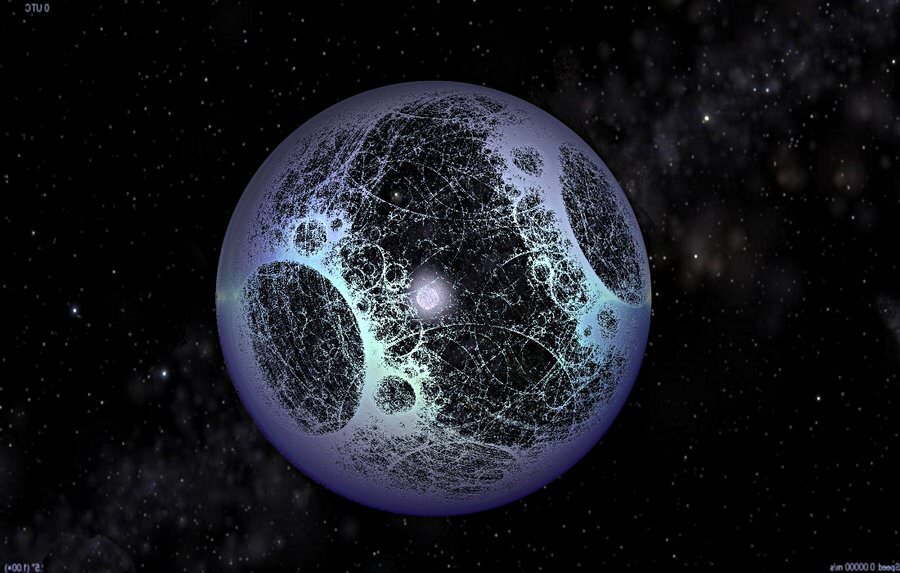The discovery of potential alien megastructures, such as Dyson spheres, within our Milky Way has sparked significant interest and debate among astronomers and enthusiasts alike. This concept, long the realm of science fiction, suggests the existence of advanced civilizations capable of building vast structures to harness energy directly from stars. More than just a flight of fancy, recent research has begun to explore this possibility using cutting-edge astronomical data.
Understanding Dyson Spheres
What is a Dyson Sphere?
A Dyson sphere is a hypothetical construct proposed by physicist Freeman Dyson in 1960. It imagines a massive shell or a swarm of satellites encompassing a star to capture a significant portion of its energy output. While a complete sphere might be implausible, a Dyson swarm—comprising a myriad of solar collectors orbiting the star—represents a more feasible alternative. The energy harnessed could support the colossal energy demands of an advanced civilization.
Imagine standing on a planet orbiting a star completely surrounded by solar collectors. The night sky would be dramatically altered, with the star’s natural light replaced by the glow of energy capture devices. For a civilization facing the energy constraints of a single planet, constructing such a structure could be a solution to power everything from basic infrastructure to interstellar travel technologies.
Historical Context and Theoretical Background
The idea of Dyson spheres originates from the need to explore how advanced civilizations might overcome energy limitations. As civilizations grow, so does their energy consumption, potentially reaching a point where planetary resources are insufficient. Dyson’s concept provides a solution by exploiting the immense, untapped energy of stars.
Historically, the concept was born out of a theoretical framework to classify civilizations based on their energy consumption, known as the Kardashev Scale. This scale posits that as civilizations evolve, they progress from harnessing energy on a planetary scale (Type I) to a stellar scale (Type II), and eventually, a galactic scale (Type III). Dyson spheres are a theoretical mechanism by which a civilization might transition from Type I to Type II.
The Project Hephaistos Initiative
Research Tools and Techniques
Project Hephaistos draws on data gathered from renowned space surveys like Gaia DR3, 2MASS, and WISE. These surveys provide comprehensive optical and infrared data, crucial for identifying anomalies that might indicate the presence of Dyson spheres. The project’s methodology involves a meticulous examination of this data to identify patterns that deviate from known stellar phenomena.
The advent of powerful telescopes and space observatories has opened new avenues in the search for extraterrestrial megastructures. For instance, the Gaia spacecraft, originally designed to map the stars in our galaxy, provides invaluable data by precisely measuring stellar positions, distances, and motion. This information can reveal unusual star dimming patterns that might suggest a Dyson structure’s presence.
Data Analysis and Findings
By scrutinizing approximately five million stellar sources, the researchers identified seven objects exhibiting unusual mid-infrared radiation. This analysis suggests these objects could be potential Dyson sphere candidates, characterized by abnormal thermal emissions indicative of energy capture and conversion processes.
To put this in perspective, the energy signature of a Dyson sphere might resemble an object radiating heat without an apparent source of light. When observed, these stars would appear dimmer in visible light but unusually bright in infrared, a key indicator of energy capture. However, distinguishing these signatures from natural cosmic phenomena remains a formidable challenge.
Potential Natural Explanations
While the findings are captivating, alternative natural explanations must be considered. Infrared emissions similar to those hypothesized for Dyson spheres can also stem from cosmic phenomena like dust rings or nebulae. These natural structures can mimic the thermal signatures expected from incomplete Dyson spheres, underscoring the need for thorough analysis.
For example, a protoplanetary disk around a young star could exhibit similar infrared characteristics. These disks, composed of dust and gas, can obscure visible light while emitting infrared radiation. Therefore, scientists must carefully analyze the data to rule out such natural phenomena before concluding the presence of a Dyson sphere.
Implications of Discovering Dyson Spheres
Technological and Scientific Ramifications
The discovery of Dyson spheres would revolutionize our understanding of both technology and astronomy. It would imply the presence of civilizations far exceeding our technological capabilities, offering insights into potential future paths for humanity.
Consider the potential technological advancements that could arise from studying such structures. Learning to harness stellar energy on a similar scale could lead to breakthroughs in renewable energy technologies on Earth. Moreover, understanding the engineering and materials science involved in constructing a Dyson sphere could inspire innovations across multiple scientific disciplines.
Philosophical and Cultural Impact
The confirmation of alien megastructures would profoundly affect human philosophy and culture. It would challenge our place in the universe, prompting a reevaluation of our role and responsibilities as an emerging technological civilization.
Our narratives, philosophies, and even religious beliefs might undergo significant transformation as we grapple with the knowledge of other advanced life forms. The discovery could unite humanity under a shared identity as part of a broader cosmic community, while also sparking debates about communication and coexistence with other civilizations.
Challenges and Future Directions
Verification and Validation
One of the primary challenges is distinguishing between genuine Dyson sphere candidates and natural cosmic phenomena. This requires advanced modeling and simulation to predict the thermal and optical characteristics of potential Dyson structures accurately.
Researchers are developing sophisticated algorithms to improve the accuracy of their models. These algorithms are designed to analyze large datasets, identify potential anomalies, and cross-reference findings with known cosmic phenomena. By refining these models, scientists can better differentiate between natural and artificial structures.
Possible Technological Developments
To advance our search, future projects might leverage improved telescopic technology and data processing algorithms. Enhanced sensitivity in infrared detection could increase the likelihood of identifying genuine Dyson sphere signatures.
Upcoming telescopes, such as the James Webb Space Telescope, promise to enhance our observational capabilities. With its superior infrared sensitivity, it could provide new insights into potential Dyson sphere candidates by observing them with greater clarity and detail.
International Collaboration and Ethical Considerations
Given the global significance of such discoveries, international collaboration is crucial. Establishing protocols for the ethical handling and sharing of data related to extraterrestrial technology is vital to ensure responsible scientific exploration.
The search for extraterrestrial megastructures transcends national boundaries, requiring a coordinated effort among scientists worldwide. Collaborative initiatives can pool resources, share data, and foster an environment of cooperation that accelerates discovery. Moreover, ethical considerations must guide the dissemination of findings, ensuring transparency and respect for potential extraterrestrial entities.
Broader Implications for Humanity
Energy Solutions and Sustainability
The concept of Dyson spheres highlights the potential for unprecedented energy solutions. While constructing such structures is beyond our current capabilities, the idea encourages innovative thinking about future energy sustainability.
Imagine a future where humanity can harness the energy of our own star, the Sun, on a much larger scale. Such advancements could drive global energy independence, reduce reliance on fossil fuels, and mitigate the impacts of climate change. The pursuit of Dyson-like structures might also inspire new approaches to energy storage and transmission, vital components of a sustainable energy future.
Encouraging Scientific Curiosity
The search for alien megastructures inspires curiosity and exploration, driving advancements in astronomy and related fields. It fosters a sense of wonder and a desire to push the boundaries of human knowledge.
The potential discovery of Dyson spheres encourages young scientists to pursue careers in space exploration, astrophysics, and engineering. It also captivates the public imagination, drawing attention to the wonders of the cosmos and the importance of scientific inquiry. This curiosity-driven pursuit of knowledge reinforces the enduring human spirit of exploration.
The ongoing research into Dyson spheres within our galaxy represents a fascinating intersection of science fiction and reality. While the current findings are intriguing, they underscore the need for continued exploration and analysis. Whether or not these structures exist, the pursuit itself enriches our understanding of the universe and our place within it.
By embracing the challenges and opportunities presented by this research, we not only strive to uncover potential extraterrestrial technologies but also deepen our appreciation for the complexities and wonders of the cosmos. This journey, filled with both scientific rigor and imaginative speculation, serves as a testament to humanity’s enduring quest for knowledge and discovery.




